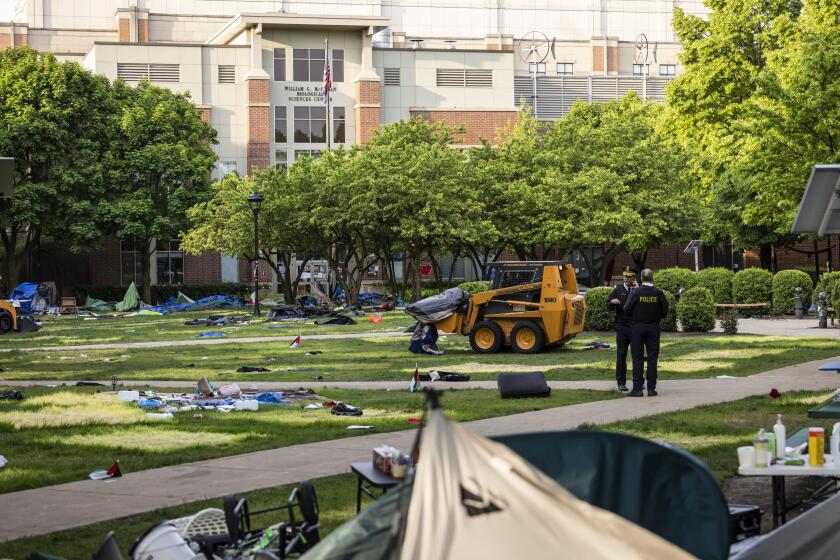UCLA seeks extra funds for hospitals
UCLA officials will ask for an additional $308 million today to complete the Ronald Reagan Medical Center on its Westwood campus and a new hospital in Santa Monica -- the latest cost overrun for the long-delayed facilities, whose total price tag will now exceed $1.3 billion.
More than half of the new funding would go toward completion of the 525-bed medical center in Westwood, already about two years behind schedule, with occupancy expected next fall. The 172-bed Santa Monica-UCLA Medical Center and Orthopaedic Hospital is scheduled to open in the winter of 2009.
UC Regent Joanne Kozberg, chairwoman of the Grounds and Buildings Committee, said the governing panel is aware of the delays and increased costs and would discuss the problems when it meets today. The full board is scheduled to vote on the matter Thursday.
“It is a matter of tremendous concern, partly because [the UC system has] five hospitals and the problems aren’t just at UCLA,” said Kozberg, noting that UC Davis has had similar troubles.
“At UCLA, the numbers are very big.”
Roughly $213.6 million of the money UCLA has requested would go toward construction and the remainder would be for furniture and equipment. The money would come from public and private sources, including federal and state grants, bond revenue, hospital and campus reserves and money raised by the university.
This is the fourth time that UCLA has asked for tens of millions of dollars in extra money for the new hospitals -- which are replacing facilities damaged in the 1994 Northridge earthquake -- since they were first approved more than six years ago.
Kozberg blamed part of the problem on escalating construction costs, particularly for steel, concrete and other materials. Hospitals in California also are racing to meet deadlines imposed by new regulations in the wake of the Northridge earthquake, she said, resulting in delays forced by overworked inspectors.
But Ronald Tutor, president of Tutor-Saliba-Perini, the general contractor for the Westwood facility, said that UCLA officials have asked for numerous design changes since the project broke ground in 1999. Contractors and subcontractors have complained that such changes, ordered late in the process, led to delays.
Steve Olsen, UCLA’s vice chancellor of finance and budget, acknowledged that the orders contributed to the problem, but said they were needed to accommodate advances in hospital medical equipment.
“Initial [hospital] design work was done in 1998,” Olsen said. “Medical technology has evolved rapidly since then.”
He pointed out, for instance, how large-scale scanners that weigh several tons have to be seismically braced and require special utility hookups.
“When a change is made in a piece of equipment,” Olsen said, “it requires redesigning part of the building itself.”
A report to the UC regents on the Westwood facility lists $58.7 million in costs for installation of medical equipment and information systems, $46.3 million for “miscellaneous design coordination change orders” and $7.5 million for a third-floor remodel.
Olsen also said that a “substantial amount” of the cost increases were due to the rising costs of construction materials.
Jan Emerson, a spokeswoman for the California Hospital Assn., said that hospital construction costs in California have escalated by as much as 66% in the last year in part because of competition for materials from countries such as China.
“We’re seeing this all over the state,” she said. “ It’s probably not going to get better any time soon.”
The Westwood facility’s biggest disruption occurred in the summer of 2004 when state inspectors issued a stop order on construction after finding a number of areas out of compliance with building codes or approved designs. It took about a year for the project to get back up to speed, but officials say no new irregularities have been found.
Olsen attributed the overruns and delays at the Santa Monica hospital, which are even larger proportionally, to bigger construction challenges. Unlike the Westwood hospital, the one in Santa Monica is being built around the medical facility it will replace.
Many of the problems there stemmed from a “substantial delay” in completion of the central plant that delivers electricity, chilled water and steam, Olsen said.
Meanwhile, John Gillengarten, acting deputy director of the office of statewide health planning and development, agreed that the rising cost of construction materials has also played a major role in overruns.
He pointed out that high-tech hospitals, particularly the much larger Westwood facility, present their own construction challenges.
“UCLA is building a state-of the art facility, with all of the ... challenges that poses,” he said. “It’s complex architecturally, complex mechanically, and all the medical equipment is complex. There really isn’t any building in the state that is comparable.... Just because of its sheer size, it’s in a class by itself.”
*
rebecca.trounson@latimes.com
*
Begin text of infobox
Hospital projects
UCLA is building two hospitals to replace its Westwood and Santa Monica facilities damaged by the 1994 Northridge earthquake. Both projects are over budget and behind schedule. The money comes from public and private sources.
Ronald Reagan UCLA Medical Center
Approved 1998 budget...$597,700,000
Subsequent augmentation...$80,000,000
Contingency...$30,000,000
Requested augmentation...$121,600,000
Total...$829,300,000
Santa Monica-UCLA Orthopaedic Hospital
Approved 1999 budget...$205,861,000
Subsequent augmentation...$70,039,000
Contingency...$10,000,000
Requested augmentation...$92,000,000
Total...$377,900,000
Replacement hospitals’ furniture and equipment
Approved 2004 budget...$85,000,000
Requested augmentation...$94,500,000
Total...$179,500,000
*
Source: UCLA
More to Read
Start your day right
Sign up for Essential California for news, features and recommendations from the L.A. Times and beyond in your inbox six days a week.
You may occasionally receive promotional content from the Los Angeles Times.






